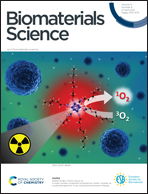Pentapeptide IKVAV-engineered hydrogels for neural stem cell attachment†
Abstract
Spinal cord injury remains irreversible with current treatment paradigms, due to the inability to rebuild the regenerative environment for neurons after injury. Neural tissue engineering that encapsulates the neural stem/progenitor cells within an artificial scaffold provides a possibility to regenerate neurons for spinal cord injury repair. The attachment and survival of these neural cells usually require similar microenvironments to the extracellular matrix for support. Here, a three-dimensional pentapeptide IKVAV-functionalized poly(lactide ethylene oxide fumarate) (PLEOF) hydrogel is developed. In vitro tests demonstrate that the IKVAV-PLEOF hydrogels are biodegradable and hemo-biocompatible. This IKVAV-PLEOF hydrogel is shown to support neural stem cell attachment, growth, proliferation, and differentiation. Additionally, the neural stem cells could be readily formed as spheroids that subsequently encapsulated, attached, and proliferated within the three-dimensional hydrogel constructs. Additionally, an in vivo test confirms the biodegradability and biocompatibility of the IKVAV-PLEOF hydrogels revealing that the hydrogels biodegrade, new blood vessels form, and few inflammatory responses are observed after 4-week implantation. The neural stem cell spheroid-laden hydrogels may have further implications in spinal cord injury regenerative and brain repair in neural tissue engineering.



 Please wait while we load your content...
Please wait while we load your content...